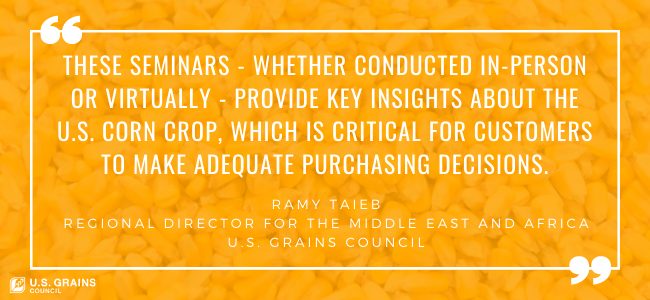For the first time, stakeholders in markets across East and West Africa attended a U.S. Grains Council (USGC) corn crop quality seminar this month. The virtual format permitted participation across the Middle East and Africa, including by participants in developing markets in Senegal, Nigeria, Kenya and Tanzania.
“This year’s crop quality seminar series allowed the Council to expand its reach and present the findings of the 2020/2021 Corn Harvest Quality Report to participants across the African continent,” said Ramy Taieb, USGC regional director for the Middle East and Africa. “While the Sub-Saharan markets are long-term markets that do not currently import significant volumes of U.S. feed grains, the seminars in North Africa were particularly timely as the feed industry in the region just bought around 800,000 metric tons (31.5 million bushels) of U.S. corn.”
The Council conducted four seminars for customers in the Europe, Middle East and Africa region this year, each catered to the specific interests of markets represented. More than 125 grain purchasers, feed millers, poultry and livestock producers and end-users attended virtually, representing more than 18 countries.
In addition to data from the harvest quality report, the seminars featured farm operation reports from farmers in Kansas, Maryland and Michigan. These on-the-ground reports provide a unique perspective of U.S. corn production, handling and processing directly from those growing the grain. Technical presentations also discussed risk management, ocean freight and the nutritional added-value of U.S. corn and distiller’s dried grains with solubles (DDGS) in poultry and livestock diets.
“The crop quality seminars over the last two weeks offered an opportunity for attendees to learn about current quality and availability of U.S. corn and co-products for export,” Taieb said. “These seminars – whether conducted in-person or virtually – provide key insights about the U.S. corn crop that are critical for customers to make adequate purchasing decisions, especially nowadays with a tight supply outside of the United States and an increasing demand for grains all over the world.”
While East and West Africa are home to relatively small poultry industries today, these operations are rapidly growing, which is why the Council is focusing its efforts on supporting the development of poultry industries in these regions. An estimated 15 percent of the global growth in poultry demand over the next two decades is expected in Africa due to increasing population, urbanization and gains in purchasing power.
These changing consumer patterns have resulted in the emergence of large grocery retailers and fast-food chains. These dynamics have also bolstered demand for animal protein, creating significant opportunities for local poultry production to grow in tandem.
The Council is working with poultry industries across the African continent to provide technical training and practical experience necessary to address both short- and long-term production challenges. The inclusion of participants from these countries in programs like the crop quality seminars is the next step of the Council’s mission to develop markets, enable trade and improve lives in the region.
About The U.S. Grains Council
The U.S. Grains Council develops export markets for U.S. barley, corn, sorghum and related products including distiller’s dried grains with solubles (DDGS) and ethanol. With full-time presence in 28 locations, the Council operates programs in more than 50 countries and the European Union. The Council believes exports are vital to global economic development and to U.S. agriculture’s profitability. Detailed information about the Council and its programs is online at www.grains.org.

